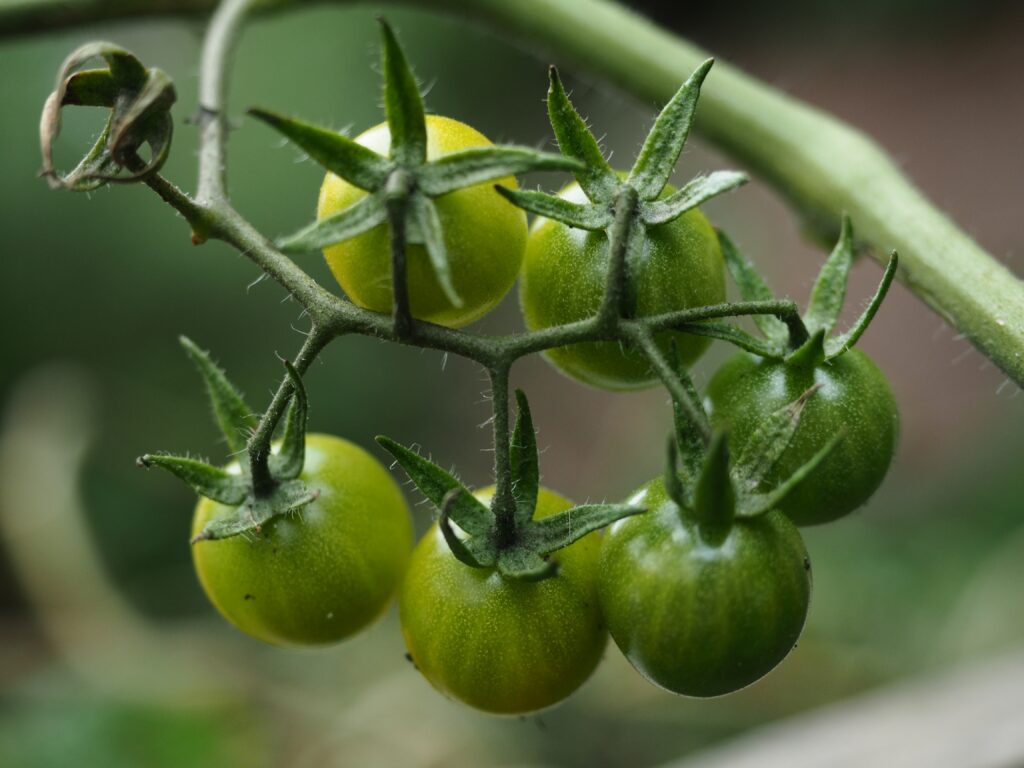Some of the links on this page are affiliate links, which means that Buzzy Kitchen earns commission from purchases made – at absolutely no extra cost to you. Thank you so much for supporting Buzzy Kitchen!
For as long as I could remember, the rules have been simple: red tomatoes are perfectly okay to eat, but green tomatoes should be avoided at all costs. But does this rule have any truth to it? Can you eat green tomatoes? And if not, why not?
Why don’t we delve a little deeper and find out?
Are Green Tomatoes Just Unripe Red Tomatoes?
Yes, green tomatoes are just unripe red tomatoes…
… for the most part.
If you leave those green tomatoes to sit for a little longer on the plant, they will likely turn to red quite quickly.
There are a few varieties of tomato that are naturally green in colour rather than red. Obviously, it wouldn’t matter how long you left a green variety of tomato on the vine, it still wouldn’t turn from green to red.

Photo by Tiago Fioreze on Unsplash
What Varieties of Tomato Are Green?
There are actually quite a few green tomato varieties, some of which you may have heard of. The list is not quite as long as their red counterparts, of course, but there are still a few there that you might wish to experiment with in the kitchen.
Green tomato varieties include:
- Green grape tomatoes
- Green zebra tomatoes
- Aunt Ruby’s German cherry tomatoes
- Cherokee green tomatoes
The most common of these are probably green zebra tomatoes, which have a sharpness to them, but are still considered quite sweet.
Are Green Tomatoes Poisonous?
Green tomatoes have the potential to be poisonous.
It’s all because of something called tomatine, which is a glycoalkaloid (a chemical compound). Tomatine also goes by the name of lycopersicin and tomatin.
Tomatine is a naturally occurring chemical compound in tomatoes, but it is considered toxic in high amounts. It can be found in green (unripe) tomatoes, as well as the leaves and stems of all tomato plants.
Red, ripe tomatoes generally contain a significantly lower amount of tomatine than green ones, which is why red tomatoes are known as safe to eat and the green ones are not. There are exceptions to this rule, of course; cherry tomatoes, even when ripe and red, contain higher than average levels of tomatine.
Larger yellow varieties of tomato can also have a higher than average tomatine content.

Photo by Karim Ghantous on Unsplash
Can Green Tomatoes Kill You?
Although green tomatoes contain more of the toxic compound tomatine than their red counterparts, it is unlikely that green tomatoes will kill you.
If you were to eat a ridiculously large amount of green tomatoes, or you were to eat them repeatedly for a long period of time, you may find yourself a little unwell; but poisoning from green tomatoes (and tomatine) is rare. Fatalities are even rarer.
What Are the Symptoms of Green Tomato Poisoning?
In laboratory animals (small rodents), tomatine poisoning presented itself with the following symptoms:
- confusion
- lethargy
- body weakness
- feeling drowsy
- diarrhoea
- nausea and vomiting
- stomach ache and pains
Studies performed back in the 1960s also showed that high doses of tomatine caused irritation of the lining of the stomach, the skin, and the eyes in mice.
Glycoalkaloid poisoning, generally, has been known to cause symptoms such as inflammation in the kidney, gastrointestinal problems and pain, an inability to properly absorb iron, and more.
Flipping things around, some studies have actually shown health benefits from controlled amounts of tomatine, including reducing LDL cholesterol.

Photo by Marc Pell on Unsplash
How many Green Tomatoes Can You Eat?
It is not known exactly how many green tomatoes you can eat before tomatine started to have toxic effects on the human body. Studies and research into tomatine, and the effects it has on the human body, have not been extensively done.
Studies have been performed on lab animals such as mice (sadly), and those studies seem to suggest that the compound is more toxic to non-mammals than it is to mammals (like humans).
